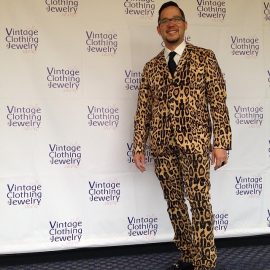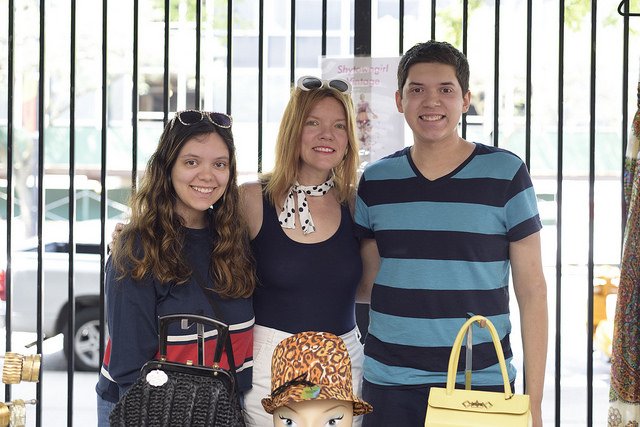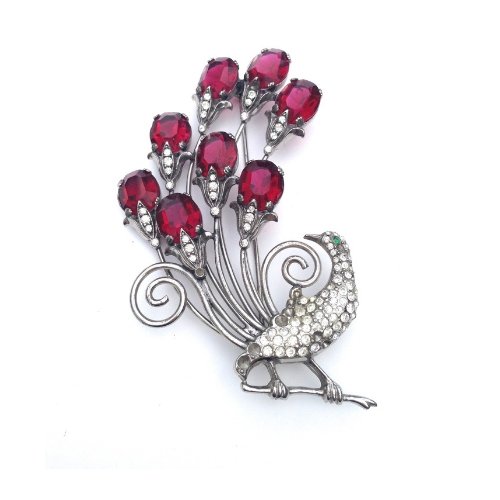
Q. How did you get started?
A. I started by accident. Initially my career choice was in bio-chemistry and molecular biolology. I was working for my PhD and I did a flea market just to get rid of some things in the house and it ended up being very lucrative. I was extremely unhappy working in the field I was going into. It was very demanding and stressful. A week after the flea market I just quit the program and the head of the department was like ‘what are you going to do?’ I said ‘I don’t know- I sold a toaster I bought for $2 for $200. I think I’m just going to get rid of some stuff.’ So I’ve been doing it ever since. I started in art deco accessories, small furniture and bar ware then reinvested. I became known as an art deco dealer and started selling in Dallas. Over time it morphed into jewelry.
The jewelry started with Bakelite because it was of the 30s. It looked nice with the cocktail shakers and things. Over time I realized that you can have more quantity in a smaller space and not break your back, and deco did dry out. Now I am 95 percent jewelry. I do pick up a cocktail shaker occasionally.
Q. How did you learn about jewelry and who are your favorite designers?
A. I learned a great deal from my best friend in Los Angeles. She is a jewelry guru and has a keen eye for everything whether its jewelry, objects, furniture or fashion. I grew up in Little Rock and Little Rock is not a capitol of fashion, but Dallas was, and is still. I started getting more exposure to different makers I had never seen before and it just developed from there. You asked about makers. I am partial to early makers like Miriam Haskell. I love Schreiner. I’m also partial to a lot of contemporary makers. One that I am in awe over is Robert Sorell. He’s done some great things and I’ve been working with him one on one. on certain projects.
Q. Do you collect?
A. I do collect. I collect a little bit of everything. The majority of what I keep for myself is in sterling silver. I collect William Spratling, Antonio Pineda. All of the great Mexican silversmiths. I collect modern jewelry like the Greenwich Village school. The LA school too. And I collect Bakelite and I am partial to the pins. Pretty much anything that amuses me.
Q. Do you sell from your collection?
A. I do. Occasionally I will. As I upgrade I move pieces I’ve had for a long time. When I buy a duplicate, one will go up for sale.
Q. What trends do you see coming up for the fall?
A. In vintage I don’t know, but I do know the trend right now is big jewelry. Whether its rings, bracelets, necklaces or earrings, the scale is very large. This will have a little effect on vintage, not much, but what’s happening is non-traditional materials are being used because gold and silver is so expensive to work with right now that even to use it for plating become expensive. You’re seeing gun metal finishes and wood, resins, sea shell and mother of pearl. With that you’ll also see with resins being popular people are buying Bakelite to go with it. The scale is large, but I do see it going small. It’s cyclical. The last cycle of minimalist jewelry was in the 90s and its coming up again.
Q. I guess that means with the price of gold and silver so high we’re losing a lot of jewelry.
A. A tremendous amount of stuff is getting melted down right now. From junk which should be melted down to great. In this day and age. At a recent show I put a pair of 14K gold earrings on the scale and had $500 on them and that day they scrapped for $525.00. No one is interested in them at $500 so it becomes difficult. With inventory that’s not moving you have to make a decision. I prefer not to scrap but sometimes– I shouldn’t say that because every antique dealer is going to yell at me, but what do you do? It becomes a big issue.
Q. Are fashion magazines and designers using more vintage pieces?
A. Pretty regularly I am seeing vintage being used. There are a couple of companies with a huge inventory and a great PR machine and they get a lot of pieces into magazines. What’s happening is they are not being branded by makers, but distributors. Ralph Lauren has their estate department. It will say vintage jewelry by Ralph Lauren even though its a Mexican silver piece.
Q. What era is big? Is the 70’s big in vintage jewelry right now?
A. The 70s is big because we’re going towards a minimalist look and the 70s were very minimalist. The early 50s was minimalist- any time there is a war the jewelry tends to go big and over-sized. When the war is over it becomes modest. That’s true for fashion too. One of the big sellers online is Lanvin-Vintage Lanvin from the 70s. It’s stuff I couldn’t give away eight years ago. Now its selling for thousands.
Q. I recently saw an article about Madeleine Albright’s pin collection being on display in Denver. Can you think of other public people with a good taste in jewelry?
A. There are a lot of semi-famous jewelry collectors, Oprah Winfrey, Diane Keaton, Whoopi Goldberg, Sarah Jessica Parker, but the biggest collectors are not celebrities. There’s a collection that’s coming out and will be on exhibit at the Museum of Art and Design. Her name is Barbra Berger and its considered to be the most important collection of vintage costume jewelry in the world. It spans every decade, category and period. It was exhibited in the Louve and in Madrid and she just finished an exhibit in Mexico City, which is where she lives. Now she’s doing New York. It’s been her biggest goal to get it in a New York museum. That’s going to a big thing for both New Yorkers and collectors.
Q. Is there a Mad men influence?
A. I have not followed Mad Men very much. I have seen the clothing, jewelry and the look. There’s definitely that trend in fashion and jewelry. With the advent of new shows like Pan Am you’re definitely going to see lots of that period of jewelry. Mad Men is very authentic in what they use. With the popularity of the show, people want the look too, or to try to mimic the look.
Q. Has selling on the Internet changed for you in the past five years?
A. Internet selling is always up and down. Sales now in general are very tough. In the past five years the Internet has exploded with inventory and pieces that were rare are no longer rare. It’s pretty easy to find what you are looking for. With the supply increasing, there’s not as much demand. It’s kind of a saturation of product unless you have something special no body else really has, its a difficult market right now. And I still think people prefer to buy retail- to shop and buy it in person. If you’re in a small town and there’s no antique show, there’s no other choice (but online).
Q. Who is the typical vintage costume jewelry collector?
A. I think its a 50s something woman who likes the history and the beauty of the art form. Jewelry collectors are very different than every other collector. I’m not trying to separate them from other passionate collectors who collect art, but I’ve known art collectors and pottery collectors but jewelry collectors are a breed of their own. They are voracious about it.
Q. What is the starting price point for costume jewelry?
A. It’s all over the place. You can by it for as little as a dollar of five dollars. Collectible pieces start at around $500. Important pieces are more than $1,000.
Q. Have you handled any of the pieces Liz Taylor did for Avon?
A. This is a collection Liz Taylor did in the 90s. The pieces were inspired by her films. It’s all very beautiful and well-made. I’ve handled only a few of the pieces because the label Avon is not really high-end. So, it’s not something marketable among my clientele. They are beautifully made. With her passing, the prices will probably go up. Everyone’s familiar with her fine jewelry collection, but she also actually had a lot of costume jewelry which is also going to be auctioned off. It’ll be interesting to see what her costume jewelry goes for. I think it will be pretty much record prices just because of provenance.
Q. Finally, what kind of advice would you give a beginning vintage costume jewelry collector?
A. This is the advice I give to everyone. Buy the best you can afford. Any antique dealer will tell you that in anything you can collect. That’s what has staying power. Quantity is not necessarily good in a collection. Quality is. A combination of both would work out too if you have the money to back it.


